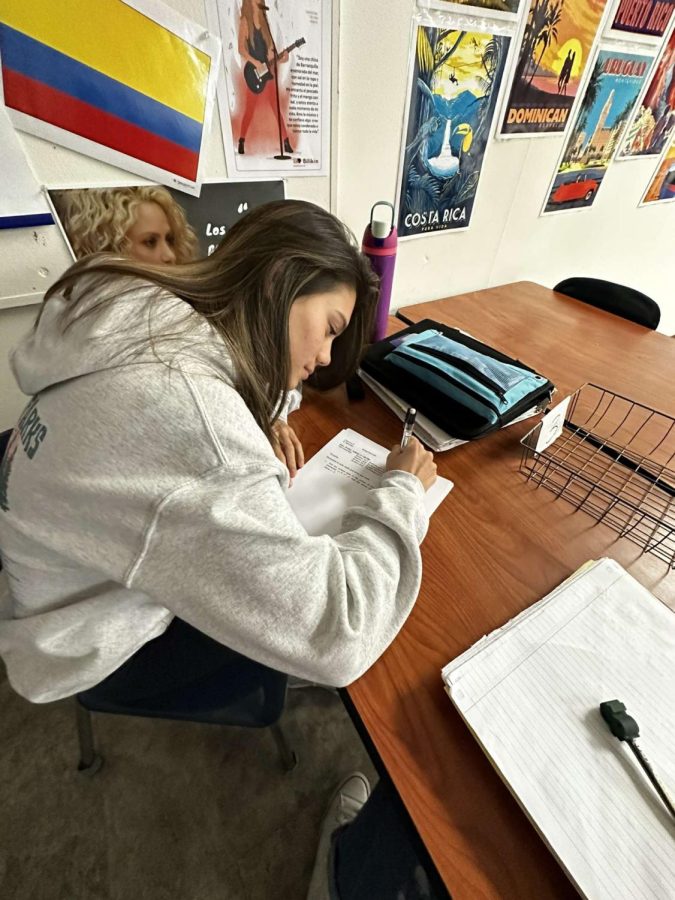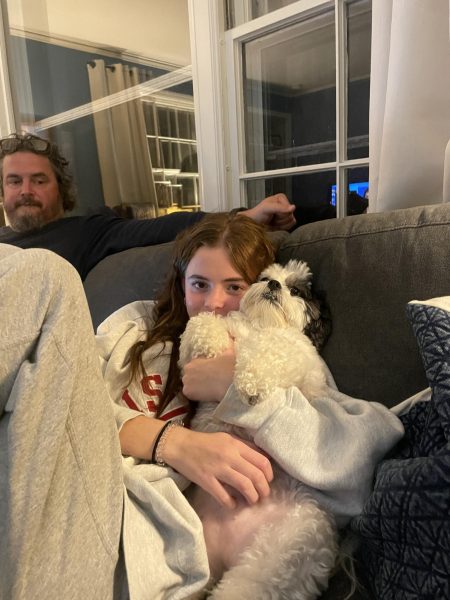Balancing High School and College
How three students at SHS are expanding their education through college courses
Blommel works on her calculus three homework during her study hall.
Stoughton High School provides many opportunities for students, but it’s hard for a high school to satisfy everyone’s academic needs. This is why seniors Megan Blommel and Lilly Talbert, as well as junior Emma Ballweg have each ventured into a post-graduation lifestyle by enrolling themselves in various college courses.
While SHS offers many AP classes for overachieving students, these three females have chosen their own path—one that comes with college professors and heavy textbooks, as well as new levels of success and struggle.
Blommel started off in algebra two her freshman year of high school when most other students in her grade were in geometry, if not algebra one. She wasn’t planning on taking a college course during high school, but the next logical step after taking calculus BC her junior year, was taking calculus three at Madison Area Technical College (MATC), according to Blommel
Q. What is the workload for this course? And how much of your time is spent completing such work?
A. It’s about seven hours of lectures every week. Then there’s one assignment every week that’s a few pages that cover the lectures. [The professor] then does a review session for the assignment, which is usually about two hours.
Q. How is this college course similar and different from classes at SHS?
A. The big thing for me was that the final and the midterm are each only 25% of your grade. So then your formatives are 50% instead of 20%. It’s also a lot of independent work, but there are still lectures and assignments.
Q. Do you recommend other high school students to take a college course while still in high school?
A. I don’t know, [calculus three] has been stressing me out because it’s really hard and during high school, is the time to be in high school. You don’t have much time because you’re in school for seven hours a day, instead of in college, where they only have classes for about two hours. [Professors] expect you to have a ton of time for homework, but you don’t.
Blommel isn’t the only student that became advanced in a subject from an early age. Ballweg started learning Spanish in fourth grade at a different school before transferring to SHS. After taking a placement test, she tested into Spanish four her freshman year. Once Ballweg completed AP Spanish, the highest level of Spanish offered at SHS, her sophomore year, she decided to enroll in UW- Madison’s Spanish 311 advanced writing practice class.
Q. How do you fit this college course into your schedule?
A. I don’t have a sixth or seventh hour. On Mondays, Wednesdays, and Fridays, my mom picks me up, and we drive to Madison. On Tuesdays and Thursdays, I don’t have a class, so I get to go home.
Q. How is this college course similar and different from classes at SHS?
A. It’s a 20-person class, so the size is pretty similar. There are also a lot of [class] discussions. In terms of differences, your teacher isn’t going to check your homework every single day. You have to be responsible and complete it with your own motivation. Before every class, there’s a section we have to read, and then a few exercises that we have to complete, but typically, it’s only 30 to 45 minutes [of homework] between each two-day chunk.
Q. Is there anything you wish you had known before taking this college course?
A. I wish I knew that most of the kids in that class are super nice and want to talk to you. I was nervous because I’m not as old as these kids and, “what are they going to think [about me]?” But they’ve all been super nice and with getting to work in groups, we talk about a ton of different things.
Another reason a student may join a college course, besides leveling out of all the ones offered at SHS in the subject, is to explore their passions. Talbert hopes to study entomology and environmental science in college. After many hours searching on Google one day, she found an online apprentice beekeeping class through the University of Montana. She hopes one day to keep bees of her own.
Q. What are the main subjects taught in this course?
A. It’s a six week-long course, and each week is different. The first subject is the anatomy of the bee and then it goes through different subjects like disease and pest management, taking care of your hive, and introduction to your hive.
Q. What is the workload for this course?
A. Each week, there are probably ten short video lectures that you need to watch. They also assign chapters in the textbook we have to read. I take notes on the videos and the textbook info, and then at the end, there’s a quiz, test, or writing assignment. Then [the course] moves on to the next subject.
Q. Do you recommend other students to take college courses during high school?
A. Yes, I would because it prepares you for what to expect in college. It prepares you for the inde- pendence of college and how to manage your time wisely.
If interested in furthering your education through college courses while still in high school, talk to Assistant Principal Dana Shoemer. Many courses through MATC, UW-Madison, and more are paid in full by SHS.

Junior Lauren Amstadt is the Norse Stars business manager as well as a staff writer. Laurens favorite part of Norse Star is being able to spread awareness...






